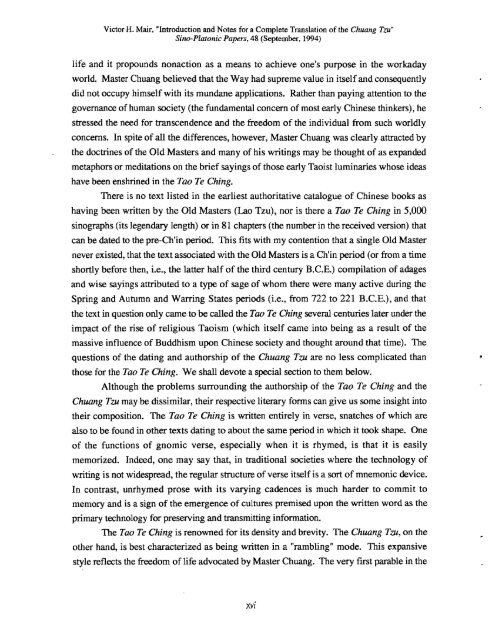Introduction and Notes for a Complete Translation of the Chuang Tzu
Introduction and Notes for a Complete Translation of the Chuang Tzu
Introduction and Notes for a Complete Translation of the Chuang Tzu
Create successful ePaper yourself
Turn your PDF publications into a flip-book with our unique Google optimized e-Paper software.
Victor H. Mair, "<strong>Introduction</strong> <strong>and</strong> <strong>Notes</strong> <strong>for</strong> a <strong>Complete</strong> <strong>Translation</strong> <strong>of</strong> <strong>the</strong> Clzuang <strong>Tzu</strong>"<br />
Sim-Platonic Papers, 48 (September, 1994)<br />
life <strong>and</strong> it propounds nonaction as a means to achieve one's purpose in <strong>the</strong> workaday<br />
world. Master <strong>Chuang</strong> believed that <strong>the</strong> Way had supreme value in itself <strong>and</strong> consequently<br />
did not occupy himself with its mundane applications. Ra<strong>the</strong>r than paying attention to <strong>the</strong><br />
governance <strong>of</strong> human society (<strong>the</strong> fundamental concern <strong>of</strong> most early Chinese thinkers), he<br />
stressed <strong>the</strong> need <strong>for</strong> transcendence <strong>and</strong> <strong>the</strong> freedom <strong>of</strong> <strong>the</strong> individual from such worldly<br />
concerns. In spite <strong>of</strong> all <strong>the</strong> differences, however, Master <strong>Chuang</strong> was clearly attracted by<br />
. <strong>the</strong> doctrines <strong>of</strong> <strong>the</strong> Old Masters <strong>and</strong> many <strong>of</strong> his writings may be thought <strong>of</strong> as exp<strong>and</strong>ed<br />
metaphors or meditations on <strong>the</strong> brief sayings <strong>of</strong> those early Taoist luminaries whose ideas<br />
have been enshrined in <strong>the</strong> Tao Te Ching.<br />
There is no text listed in <strong>the</strong> earliest authoritative catalogue <strong>of</strong> Chinese books as<br />
having been written by <strong>the</strong> Old Masters (Lao <strong>Tzu</strong>), nor is <strong>the</strong>re a Tao Te Ching in 5,000<br />
sinographs (its legendary length) or in 8 1 chapters (<strong>the</strong> number in <strong>the</strong> received version) that<br />
can be dated to <strong>the</strong> pre-Ch'in period. This fits with my contention that a single Old Master<br />
never existed, that <strong>the</strong> text associated with <strong>the</strong> Old Masters is a Ch'in period (or from a time<br />
shortly be<strong>for</strong>e <strong>the</strong>n, i.e., <strong>the</strong> latter half <strong>of</strong> <strong>the</strong> third century B.C.E.) compilation <strong>of</strong> adages<br />
<strong>and</strong> wise sayings attributed to a type <strong>of</strong> sage <strong>of</strong> whom <strong>the</strong>re were many active during <strong>the</strong><br />
Spring <strong>and</strong> Autumn <strong>and</strong> Warring States periods (i.e., from 722 to 221 B.C.E.), <strong>and</strong> that<br />
<strong>the</strong> text in question only came to be called <strong>the</strong> Tao Te Ching several centuries later under <strong>the</strong><br />
impact <strong>of</strong> <strong>the</strong> rise <strong>of</strong> religious Taoism (which itself came into being as a result <strong>of</strong> <strong>the</strong><br />
massive influence <strong>of</strong> Buddhism upon Chinese society <strong>and</strong> thought around that time). The<br />
questions <strong>of</strong> <strong>the</strong> dating <strong>and</strong> authorship <strong>of</strong> <strong>the</strong> <strong>Chuang</strong> Tm are no less complicated than<br />
those <strong>for</strong> <strong>the</strong> Tao Te Ching. We shall devote a special section to <strong>the</strong>m below.<br />
Although <strong>the</strong> problems surrounding <strong>the</strong> authorship <strong>of</strong> <strong>the</strong> Tao Te Ching <strong>and</strong> <strong>the</strong><br />
<strong>Chuang</strong> Tm may be dissimilar, <strong>the</strong>ir respective literary <strong>for</strong>ms can give us some insight into<br />
<strong>the</strong>ir composition. The Tao Te Ching is written entirely in verse, snatches <strong>of</strong> which are<br />
also to be found in o<strong>the</strong>r texts dating to about <strong>the</strong> same period in which it took shape. One<br />
<strong>of</strong> <strong>the</strong> functions <strong>of</strong> gnomic verse, especially when it is rhymed, is that it is easily<br />
memorized. Indeed, one may say that, in traditional societies where <strong>the</strong> technology <strong>of</strong><br />
writing is not widespread, <strong>the</strong> regular structure <strong>of</strong> verse itself is a sort <strong>of</strong> mnemonic device.<br />
In contrast, unrhymed prose with its varying cadences is much harder to commit to<br />
memory <strong>and</strong> is a sign <strong>of</strong> <strong>the</strong> emergence <strong>of</strong> cultures premised upon <strong>the</strong> written word as <strong>the</strong><br />
primary technology <strong>for</strong> preserving <strong>and</strong> transmitting in<strong>for</strong>mation.<br />
The Tao Te Ching is renowned <strong>for</strong> its density <strong>and</strong> brevity. The <strong>Chuang</strong> Tnr, on <strong>the</strong><br />
o<strong>the</strong>r h<strong>and</strong>, is best characterized as being written in a "ramblingt' mode. This expansive<br />
style reflects <strong>the</strong> fkeedom <strong>of</strong> life advocated by Master <strong>Chuang</strong>. The very first parable in <strong>the</strong>
















